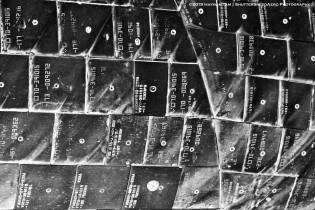 @Steven F. Udvar-Hazy Center, Chantilly, VA
@Steven F. Udvar-Hazy Center, Chantilly, VA
August 2018
Of all the Space Shuttles built, the Discovery has to be my favorite. Not only is it the Shuttle that carried the Hubble Space Telescope into orbit, it is also the only Space Shuttle I had the privilege to climb into while I was working on the HST program. Entering service in 1984, Discovery was the third Space Shuttle orbiter vehicle to fly in space. Each shuttle is covered by more than 24,000 of these LI-900 thermal protection system (TPS) tile blocks. To allow for thermal expansion of the orbiter, the tiles are bonded to flexible felt-like pads, which are then glued to the orbiter. The tiles are exposed to reentry temperatures of up to 2,300 degrees F, such as these under the nose, have a coating of black glass which reflect about 90% of the heat back into the atmosphere, with the rest of the heat absorbed by the tile. All TPS tiles are assigned a serial number identifying where on the orbiters they are to be installed. Each tile is individually made to fit a specific location. Deciphering the code: “VO” is vehicle orbiter, “391xxx” is the location (Forward fuselage upper, lower). The TPS tiles were developed and manufactured by Lockheed Missiles and Space Company. Discovery is preserved as intact as possible as it last flew in 2011 on the 133rd Space Shuttle mission. NASA transferred Discovery to the Smithsonian in April 2012 after a delivery flight over the nation’s capital. Fuji X-E2s w/18-55mm.
